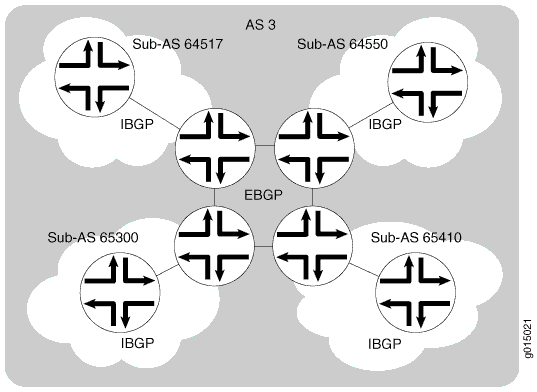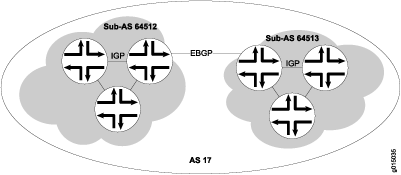BGP Confederations for IBGP Scaling
Understanding BGP Confederations
BGP confederations are another way to solve the scaling problems created by the BGP full mesh requirement. BGP confederations effectively break up a large autonomous system (AS) into subautonomous systems (sub-ASs). Each sub-AS must be uniquely identified within the confederation AS by a sub-AS number. Typically, sub-AS numbers are taken from the private AS numbers between 64,512 and 65,535.
Within a sub-AS, the same internal BGP (IBGP) full mesh requirement exists. Connections to other confederations are made with standard external BGP (EBGP), and peers outside the sub-AS are treated as external. To avoid routing loops, a sub-AS uses a confederation sequence, which operates like an AS path but uses only the privately assigned sub-AS numbers.
The confederation AS appears whole to other confederation ASs. The AS path received by other ASs shows only the globally assigned AS number. It does not include the confederation sequence or the privately assigned sub-AS numbers. The sub-AS numbers are removed when the route is advertised out of the confederation AS. Figure 1 shows an AS divided into four confederations.

Figure 1 shows AS 3 divided into four sub-ASs, 64517, 64550, 65300, and 65410, which are linked through EBGP sessions. Because the confederations are connected by EBGP, they do not need to be fully meshed. EBGP routes are readvertised to other sub-ASs.
See Also
Example: Configuring BGP Confederations
This example shows how to configure BGP confederations.
Requirements
-
Configure network interfaces.
-
Configure external peer sessions. See Example: Configuring External BGP Point-to-Point Peer Sessions.
-
Configure interior gateway protocol (IGP) sessions between peers.
-
Configure a routing policy to advertise the BGP routes.
Overview
Within a BGP confederation, the links between the confederation member autonomous systems (ASs) must be external BGP (EBGP) links, not internal BGP (IBGP) links.
Similar to route reflectors, BGP confederations reduce the number of peer sessions and TCP sessions to maintain connections between IBGP routing devices. BGP confederation is one method used to solve the scaling problems created by the IBGP full mesh requirement. BGP confederations effectively break up a large AS into subautonomous systems. Each sub-AS must be uniquely identified within the confederation AS by a sub-AS number. Typically, sub-AS numbers are taken from the private AS numbers between 64512 and 65535. Within a sub-AS, the same IBGP full mesh requirement exists. Connections to other confederations are made with standard EBGP, and peers outside the sub-AS are treated as external. To avoid routing loops, a sub-AS uses a confederation sequence, which operates like an AS path but uses only the privately assigned sub-AS numbers.
Figure 2 shows a sample network in which AS 17 has two separate confederations: sub-AS 64512 and sub-AS 64513, each of which has multiple routers. Within a sub-AS, an IGP is used to establish network connectivity with internal peers. Between sub-ASs, an EBGP peer session is established.

Topology
Configuration
Procedure
CLI Quick Configuration
To quickly configure this example, copy the
following commands, paste them into a text file, remove any line breaks,
change any details necessary to match your network configuration,
and then copy and paste the commands into the CLI at the [edit] hierarchy level.
All Devices in Sub-AS 64512
set routing-options autonomous-system 64512 set routing-options confederation 17 members 64512 set routing-options confederation 17 members 64513 set protocols bgp group sub-AS-64512 type internal set protocols bgp group sub-AS-64512 local-address 192.168.5.1 set protocols bgp group sub-AS-64512 neighbor 192.168.8.1 set protocols bgp group sub-AS-64512 neighbor 192.168.15.1
Border Device in Sub-AS 64512
set protocols bgp group to-sub-AS-64513 type external set protocols bgp group to-sub-AS-64513 peer-as 64513 set protocols bgp group to-sub-AS-64513 neighbor 192.168.5.2
All Devices in Sub-AS 64513
set routing-options autonomous-system 64513 set routing-options confederation 17 members 64512 set routing-options confederation 17 members 64513 set protocols bgp group sub-AS-64513 type internal set protocols bgp group sub-AS-64513 local-address 192.168.5.2 set protocols bgp group sub-AS-64513 neighbor 192.168.9.1 set protocols bgp group sub-AS-64513 neighbor 192.168.16.1
Border Device in Sub-AS 64513
set protocols bgp group to-sub-AS-64512 type external set protocols bgp group to-sub-AS-64512 peer-as 64512 set protocols bgp group to-sub-AS-64512 neighbor 192.168.5.1
Step-by-Step Procedure
This procedure shows the steps for the devices that are in sub-AS 64512.
The autonomous-system statement sets the sub-AS number
of the device.
The following example requires you to navigate various levels in the configuration hierarchy. For information about navigating the CLI, see Using the CLI Editor in Configuration Mode in the Junos OS CLI User Guide.
To configure BGP confederations:
-
Set the sub-AS number for the device.
[edit routing-options] user@host# set autonomous-system 64512 -
In the confederation, include all sub-ASs in the main AS.
The number 17 represents the main AS. The
membersstatement lists all the sub-ASs in the main AS.[edit routing-options confederation] user@host# set 17 members 64512 user@host# set 17 members 64513
-
On the border device in sub-AS 64512, configure an EBGP connection to the border device in AS 64513.
[edit protocols bgp group to-sub-AS-64513] user@host# set type external user@host# set neighbor 192.168.5.2 user@host# set peer-as 64513
-
Configure an IBGP group for peering with the devices within sub-AS 64512.
[edit protocols bgp group sub-AS-64512] user@host# set type internal user@host# set local-address 192.168.5.1 user@host# neighbor 192.168.8.1 user@host# neighbor 192.168.15.1
Results
From configuration mode, confirm your configuration
by entering the show routing-options and show protocols commands. If the output does not display the intended configuration,
repeat the instructions in this example to correct the configuration.
user@host# show routing-options autonomous-system 64512; confederation 17 members [ 64512 64513 ];
user@host# show protocols
bgp {
group to-sub-AS-64513 { # On the border devices only
type external;
peer-as 64513;
neighbor 192.168.5.2;
}
group sub-AS-64512 {
type internal;
local-address 192.168.5.1;
neighbor 192.168.8.1;
neighbor 192.168.15.1;
}
}If you are done configuring the device, enter commit from configuration mode. Repeat these steps for
sSub-AS 64513.
Verification
Confirm that the configuration is working properly.
Verifying BGP Neighbors
Purpose
Verify that BGP is running on configured interfaces and that the BGP session is active for each neighbor address.
Action
From the CLI, enter the show bgp neighbor command.
Sample Output
command-name
user@host> show bgp neighbor
Peer: 10.255.245.12+179 AS 35 Local: 10.255.245.13+2884 AS 35
Type: Internal State: Established (route reflector client)Flags: Sync
Last State: OpenConfirm Last Event: RecvKeepAlive
Last Error: None
Options: Preference LocalAddress HoldTime Cluster AddressFamily Rib-group Refresh
Address families configured: inet-vpn-unicast inet-labeled-unicast
Local Address: 10.255.245.13 Holdtime: 90 Preference: 170
Flags for NLRI inet-vpn-unicast: AggregateLabel
Flags for NLRI inet-labeled-unicast: AggregateLabel
Number of flaps: 0
Peer ID: 10.255.245.12 Local ID: 10.255.245.13 Active Holdtime: 90
Keepalive Interval: 30
NLRI advertised by peer: inet-vpn-unicast inet-labeled-unicast
NLRI for this session: inet-vpn-unicast inet-labeled-unicast
Peer supports Refresh capability (2)
Restart time configured on the peer: 300
Stale routes from peer are kept for: 60
Restart time requested by this peer: 300
NLRI that peer supports restart for: inet-unicast inet6-unicast
NLRI that restart is negotiated for: inet-unicast inet6-unicast
NLRI of received end-of-rib markers: inet-unicast inet6-unicast
NLRI of all end-of-rib markers sent: inet-unicast inet6-unicast
Table inet.0 Bit: 10000
RIB State: restart is complete
Send state: in sync
Active prefixes: 4
Received prefixes: 6
Suppressed due to damping: 0
Table inet6.0 Bit: 20000
RIB State: restart is complete
Send state: in sync
Active prefixes: 0
Received prefixes: 2
Suppressed due to damping: 0
Last traffic (seconds): Received 3 Sent 3 Checked 3
Input messages: Total 9 Updates 6 Refreshes 0 Octets 403
Output messages: Total 7 Updates 3 Refreshes 0 Octets 365
Output Queue[0]: 0
Output Queue[1]: 0
Trace options: detail packets
Trace file: /var/log/bgpgr size 131072 files 10Meaning
The output shows a list of the BGP neighbors with detailed session information. Verify the following information:
-
Each configured peering neighbor is listed.
-
For
State, each BGP session isEstablished. -
For
Type, each peer is configured as the correct type (either internal or external). -
For
AS, the AS number of the BGP neighbor is correct.
Verifying BGP Groups
Purpose
Verify that the BGP groups are configured correctly.
Action
From the CLI, enter the show bgp group command.
Sample Output
command-name
user@host> show bgp group Group Type: Internal AS: 10045 Local AS: 10045 Name: pe-to-asbr2 Flags: Export Eval Export: [ match-all ] Total peers: 1 Established: 1 10.0.0.4+179 bgp.l3vpn.0: 1/1/0 vpn-green.inet.0: 1/1/0 Groups: 1 Peers: 1 External: 0 Internal: 1 Down peers: 0 Flaps: 0 Table Tot Paths Act Paths Suppressed History Damp State Pending bgp.l3vpn.0 1 1 0 0 0 0
Meaning
The output shows a list of the BGP groups with detailed group information. Verify the following information:
-
Each configured group is listed.
-
For
AS, each group's remote AS is configured correctly. -
For
Local AS, each group's local AS is configured correctly. -
For
Group Type, each group has the correct type (either internal or external). -
For
Total peers, the expected number of peers within the group is shown. -
For
Established, the expected number of peers within the group have BGP sessions in theEstablishedstate. -
The IP addresses of all the peers within the group are present.
Verifying BGP Summary Information
Purpose
Verify that the BGP configuration is correct.
Action
From the CLI, enter the show bgp summary command.
Sample Output
command-name
user@host> show bgp summary Groups: 1 Peers: 3 Down peers: 0 Table Tot Paths Act Paths Suppressed History Damp State Pending inet.0 6 4 0 0 0 0 Peer AS InPkt OutPkt OutQ Flaps Last Up/Dwn State|#Active/Received/Damped... 10.0.0.2 65002 88675 88652 0 2 42:38 2/4/0 0/0/0 10.0.0.3 65002 54528 54532 0 1 2w4d22h 0/0/0 0/0/0 10.0.0.4 65002 51597 51584 0 0 2w3d22h 2/2/0 0/0/0
Meaning
The output shows a summary of BGP session information. Verify the following information:
-
For
Groups, the total number of configured groups is shown. -
For
Peers, the total number of BGP peers is shown. -
For
Down Peers, the total number of unestablished peers is 0. If this value is not zero, one or more peering sessions are not yet established. -
Under
Peer, the IP address for each configured peer is shown. -
Under
AS, the peer AS for each configured peer is correct. -
Under
Up/Dwn State, the BGP state reflects the number of paths received from the neighbor, the number of these paths that have been accepted, and the number of routes being damped (such as 0/0/0). If the field isActive, it indicates a problem in the establishment of the BGP session.
